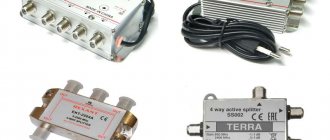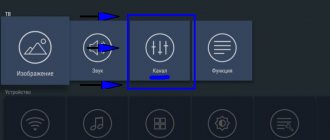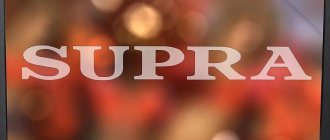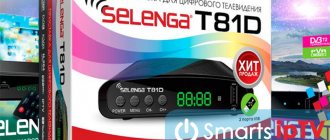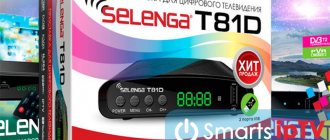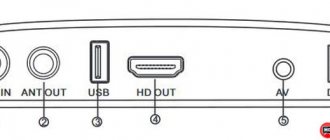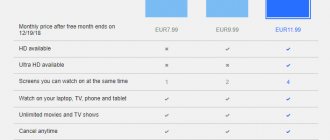The transition to digital television cannot be avoided. And various modifications of antenna equipment began to appear on the market. Among them appeared an antenna with an amplification board for 5 to 12 volts.
Voltage is supplied to the antenna equipment from a digital dvb t2 set-top box, a TV via a USB injector or a network adapter with a rating of 5-12V/0.5Am. Next, we’ll figure out how to turn on the power to the antenna.
How to turn on the antenna power on your TV
Unfortunately, not all TVs can supply voltage to the amplification board. If your TV supports this feature, then consider yourself lucky. Turning on the TV occurs in the same way as on a digital set-top box. Through the TV menu. If such a function is not found, you will have to spend a couple of hundred to purchase a USB injector.
“USB injector - a device designed to supply voltage to an active antenna from the USB port of a TV receiver, network adapter, dvb-t2 set-top box.”
Allows you to connect antenna equipment to a USB port, without a 220 V network unit. There are no extra wires or current consumers. A secure way to connect.
Digital TV. Educational program. How to supply power from a TV to an active digital TV antenna DVB-T2
Our expert Stanislav Boush Says:
An active TV antenna differs from a passive one in that it has a television signal amplifier inside it.
A passive antenna does not have an amplifier using transistors or microcircuits. Reception occurs by pointing the antenna towards the TV tower. The antenna is designed in such a way that the signal is amplified from one direction and weakened from all others. The reception sector is usually 10-20 degrees; very good antennas can even be 5 degrees. That is, the stronger the antenna, the more accurately it must be directed to the source of the TV signal. If you need a powerful antenna, it must be long. The correct maximum length of a passive antenna is approximately 1.3 - 1.5 meters. There are antennas without an amplifier 2-2.5 meters long, but this is necessary for reception from 80-100 km. And by the way, it’s not a fact that everything will work out. An active antenna contains an amplifier. And the amplifier gain is added to the antenna gain. That is, if a passive antenna has a gain of 8 decibels, then an active antenna with an added amplifier of 20 decibels will have a total gain of 28 decibels.
THE AMPLIFIER IS WHAT TURNES A PASSIVE ANTENNA INTO AN ACTIVE!
In order for the amplifier to work, it must be supplied with supply voltage. In modern antennas, 5 Volt power is supplied through the central core of the cable. 12 Volt antenna television network adapters are slowly but steadily becoming a thing of the past (antenna power supplies that plug into a 220 volt outlet). There are more modern solutions. Much more convenient.
How to supply 5 volt power to the antenna via the antenna cable? You will learn about this from the article.
Here is an antenna, for example, an indoor directional active one, called T-3310, produced by antenna.ru. When power is applied, the indicator LED lights up.
The first supply method is power from a TV receiver (digital set-top box). In all, absolutely all receivers, the function of turning on the antenna power is implemented.
To do this, in the receiver menu you need to find the Antenna Power item and switch from OFF to ON. Like this:
How do you turn on power to the antenna on your TV? If he is a modern SMART TV? But no way! Unfortunately, Digital TVs do not have such a function! Not LG, not Samsung, not JVC! Not on any TVs!
Don't ask me why - it's not done!
Therefore, the question of how to supply power to an active antenna in modern TVs is very important to understand.
There is an exit!
Therefore, to power active antennas, a special device was invented, which for some reason is called not a power supply, but a power injector.
Video “How to connect an active antenna to a TV” on YOUTUBE
Antenna.ru channel is with you!
The main idea of the developers was that the antenna should be powered from the USB connector of a modern TV, this is done in this way:
The injector has three connectors - USB, TV male, TV female.
We plug the USB into the USB of the TV, TV dad into the TV socket of the TV, TV mom into the antenna!
iiiiiiiii…………
Dadishch!
And half of modern TVs do not supply power to the USB connector! More precisely, it is served, but only if you insert a flash drive into it and select Watch a movie or Listen to music from USB in the TV menu. But our task is completely different, we want to watch 20 free DVB-T2 channels from the air, and not recordings from a flash drive.
What to do? It's simple! You must use a mobile phone charger. Here, for example, is this one. We plug the USB injector not into the TV, but into the power supply.
Voila! The LED on the antenna lights up, which means we have connected the antenna correctly.
Attention! A power injector without an LED indicator indicator is an extremely mysterious thing - it is absolutely unclear whether it received power from USB, whether it supplied 5 Volt power to the active antenna - without an indicator, all this is a mystery shrouded in darkness. This is why I recommend the Triada-311 power injector with an indicator LED (a link to it is at the end of the article).
LED in the T-3320 antenna/antenna.ru
And one more thing: There are antennas on sale with a USB injector built directly into the antenna.
However, the length of the USB cable and antenna cable for such antennas is usually very short, about 50 centimeters, so it is convenient to use such antennas only in an area of reliable reception, because if the antenna needs to be carried three meters from the TV, now two extension cords will be needed. You will have to buy both an antenna extender and a USB extender.
So, to the question “which TV set-top box supplies power to the antenna”, the answer is any!
So, to the question “which TV can supply power to the antenna”, the answer is - very few!
Conclusion: if you don’t have a digital set-top box, but have a modern TV with DVB-T2, use the Triad-311 injector and a phone charger to connect power to the active antenna.
That's all!
Thus, it is best to supply power to an active television antenna from a USB TV injector (5 Volts).
The antenna.ru channel and our expert Stanislav Boush were with you!
Subscribe, like, we work for you!
Other connection methods
Well, if you don’t have USB on your TV, then all you have to do is use the power supply. A charging unit for a phone or tablet with a USB output and a rating of 5-12V/0.5A is suitable. The following shows a diagram of connecting active equipment from a digital terrestrial set-top box or TV through a divider. For this wiring method, the signal divider must be power-through. You can use a splitter for satellite television.
The second circuit does not use a divider, and the set-top boxes are connected in series through the loop output on the receiver. The power to the antenna equipment is turned on at the set-top box. The same as in the first connection option.
The connection diagram using the adapter can be found here.
Antenna for digital TV
The set-top box itself will not provide channels - to watch digital television you need an antenna capable of receiving and, if necessary, amplifying the signal.
How to select and connect a TV antenna for receiving digital TV is described in great detail in the following video:
What kind of antenna is needed for a digital set-top box to watch free television channels depends on several factors:
- distance to the television transmitter and its power;
- the area in which the equipment is installed;
- the presence of trees and structures near the house that interfere with the signal;
- floor.
Thanks to these factors, you can determine which TV antenna you need to install to watch digital TV. If the TV is located at a distance of up to 15 km from the transmitter, then you can install a simple indoor antenna. If the area is mountainous, forested, or built up with high-rise buildings, then a device is needed that enhances the reception of a television signal.
You can configure any existing equipment to receive a digital signal. If you didn’t have one before, you can select one based on your living conditions. You should figure out whether an antenna is needed for a digital set-top box , and how they differ from each other.
Active and passive
A passive antenna is one that receives a signal and transmits it to the TV. A simple device, sometimes in the immediate vicinity of the transmitter an ordinary wire or nail can act as a passive television antenna.
The active one is equipped with an amplifier that not only picks up signals, but also amplifies them. Some active antennas are equipped with special filters. This prevents interference from cellular signals. Such filters are also sold separately and, if necessary, can be installed independently. An active TV antenna runs on electricity and is equipped with a power supply.
Indoor and outdoor
Regardless of whether the antenna is equipped with an amplifier or not, it can be used indoors or installed outdoors. Typically, indoor equipment is compact. If desired, it can be rearranged and adjusted in order to catch a high-quality signal.
The street one is installed outside. As a rule, they try to lift it onto the roof, and if this is not possible, then put it outside the window. Outdoor devices are much larger than indoor ones. The length of the receiving elements can be up to 4 meters.
When installing, you should take into account the location of the signal transmitter and point the antenna towards it. You also need to remember that electrical wires can interfere with signal reception, and install the TV antenna at some distance. If the roof of the house is made of corrugated sheets or metal tiles, then the device should not be placed on it to avoid interference.
To date, several antenna models have been developed that can be used both indoors and outdoors.
Setting up the tuner and receiving T-2 channels.
I will describe my particular case of manufacturing antennas for digital television T-2 :
Normally, my TVs worked with an external “Polish” antenna with an amplifier. The reception was more or less satisfactory. However, the first time the T-2 tuner refused to work with it, displaying the message “no signal” on the screen. I racked my brains for a long time until I checked the box next to the “ antenna power from TV tuner ” option in the tuner settings. After that, several channels immediately appeared. This is the trick for antennas with an amplifier...
An important point - when buying a tuner, you need to ask that the channels be tuned in the store, otherwise you may not be able to receive anything either because of the antenna or because the tuner is not configured . This will be an equation with many unknowns. Digital television assumes either the presence of a signal or its absence. It won’t work like adjusting the signal in analog television. He either exists or he doesn’t. On an untuned tuner it will be difficult to determine the reason for the lack of signal.
In general, having received several channels, I realized that the rest were not received due to a not quite suitable antenna. It must be admitted that not all analogue channels were satisfactorily received on my outdoor “Polish” antenna with an amplifier. It is clear that digital television will not be received well. They will not be accepted at all. You need a good antenna.
Kharchenko antenna for T-2.
After rummaging on the Internet, I came across a simple and universal Kharchenko antenna . It is broadband, with constant parameters throughout the entire range, and does not require special settings.
Used for radio communications on HF, VHF, reception of television channels and Wi-Fi. The range of the antenna is determined by its geometric parameters - the side of the square is equal to ¼ of the wavelength.
That is, everything is simple - for example, in some city, the frequency range for receiving the T-2 television signal is in the region of 550 MHz - 650 MHz. The middle of the range is 600 MHz.
Let's convert the frequency into wavelength: - divide the speed of radio waves (300,000) by the frequency.
300000 / 600 MHz = 500 mm – mid-range wavelength.
The side of a square is 500mm/4 (¼ wavelength). We get 125 mm - the side of a square for an antenna with an average frequency of 600 MHz.
In general, for each city, the frequencies of T-2 digital television transmissions will be different. There are tables of frequencies and channel numbers for T2 digital terrestrial television for each city. They can be easily found on the Internet. You need to find out the frequency limits of the T-2 signal in a particular city, and calculate the middle of the range. Based on these data, we will obtain the dimensions of the Kharchenko antenna. In general, the point is to find your city in the table, determine the boundaries of the range and calculate its middle, for which you need to make an antenna (calculate the sides of the antenna squares).
There are also a huge number of online Kharchenko antenna calculators , by entering data (frequency) into which you can obtain the necessary geometric parameters of the antenna.
